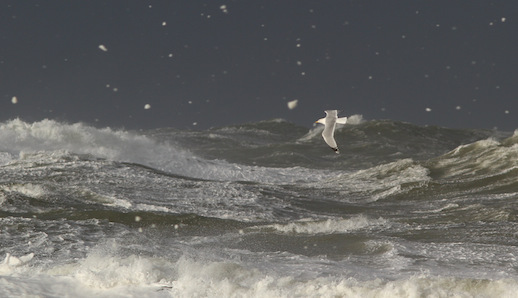Words: Jon Gower.
Approaching An Island
Outside’s a swirl of black and silver.
The lighthouse swings its white bird round
as if one day it will let go
the string, and let the loosed light fly
back to its roost with the calling stars.
(From Christine Evans, ‘Enlli’)
White cats-paws of waves lick at the sides of the boat leaving Porth Meudwy, the hermit’s cove, and as we move out to open water smutty plumes of diesel follow in our wake, along with lesser black-backed gulls which fly alongside like police outriders. In mid-channel an arctic skua, passing through on passage, lives up to its piratical reputation as it dive-bombs some guillemots, trying to force the auks to disgorge their catch. A nervous one surrenders its lunch in a spray of sand eels.
And then the island proper, Ynys Enlli, or Bardsey, hoves into full view. While the eastern hump of Y Mynydd, The Mountain, at 548 feet, is a mere bagatelle of a climb, it is made of tough stuff, made from some of the oldest rock on earth, Precambrian, six hundred million years old. It certainly makes the human timescale, the Biblical three score and ten seem like a pitiful trifle, a mere instant. Y Mynydd commands the view as one approaches by sea: once on land the westerly edge of the island looks surprisingly inhabited, with a succession of houses. These nestle in pairs – Tŷ Nesaf and Tŷ Bach, Nant and Hendy – and are arranged at generous intervals along the A1, the ironically named cart track that runs south to north from Y Cafn, the artificial harbour dynamited into existence by Trinity House. At its widest the island has a girth of a mile and a half and it’s two and a half miles long. But it has incredible depth of history. Saint Cadfan built a monastery here in the sixth century. Pirates and smugglers have used it as a base. It’s drawn holy seekers, twentieth century survivalists, crab fishermen and saints. As the archaeologist Mary Chitty put it: ‘Trying to spell out the history of the island is like watching the island itself from the headland. Sometimes the outline is clear and hard, its detail visible; more often in shifting gleaming light and shadows it seems to dissolve and float away. Sometimes it disappears altogether in the fog. Then only the mountain saying amen to the lighthouse tells us Bardsey is still there.’
The lighthouse was built on the southern islet of Enlli in 1821 at a cost of £5,470, with a staggering three thousand pounds outlay for the lens itself. By day it’s a hundred foot high, limestone tower composed, Lego-style, of horizontal red and white blocks. It’s he same colour scheme as an old-fashioned barber’s pole, and a pretty unique structure in the realm of lighthouse design in being so square. Within the lantern houses five heavy lenses, sitting on a bed of mercury, surrounding a bulb which is only 400 watts. The mercury is the ingenious answer to the problem of a lens being too heavy to rotate. Floating it on a bed of quicksilver means you can turn it with a finger.
The lighthouse keepers are long gone from the place. It was automated in 1986, with the last principal keeper, Harry Whitehouse, retiring that same year: the light is now operated from the Trinity House command centre in Harwich.
Paradoxically Enlli’s is a deadly light, a real killer. The light, distinctively flashing five times every 15 seconds, has long been notorious for luring migrating birds to their deaths. The phenomenon, peculiar to just a handful of locations in the UK, is known as an attraction. On the worst occasion up to forty thousand individuals from a wide range of species have been attracted to their deaths in a single night, striking the tower, stunned to the ground.
After an attraction, dawn’s macabre crop of corpses might include hundreds of birds from a single species, a massacre of redwings or a wastage of willow warblers. At one stage things were so bad that the Royal Society for the Protection of Birds made a film about the island with the subtitle “A Death Trap,” as if Charles Bronson had been appointed keeper. It shows ghostly flights of birds winging in towards the light and, consequently, a funereal procession of volunteers carrying wooden boxes to pick up dead or fallen birds. To list the species lying there is to pen a litany.
